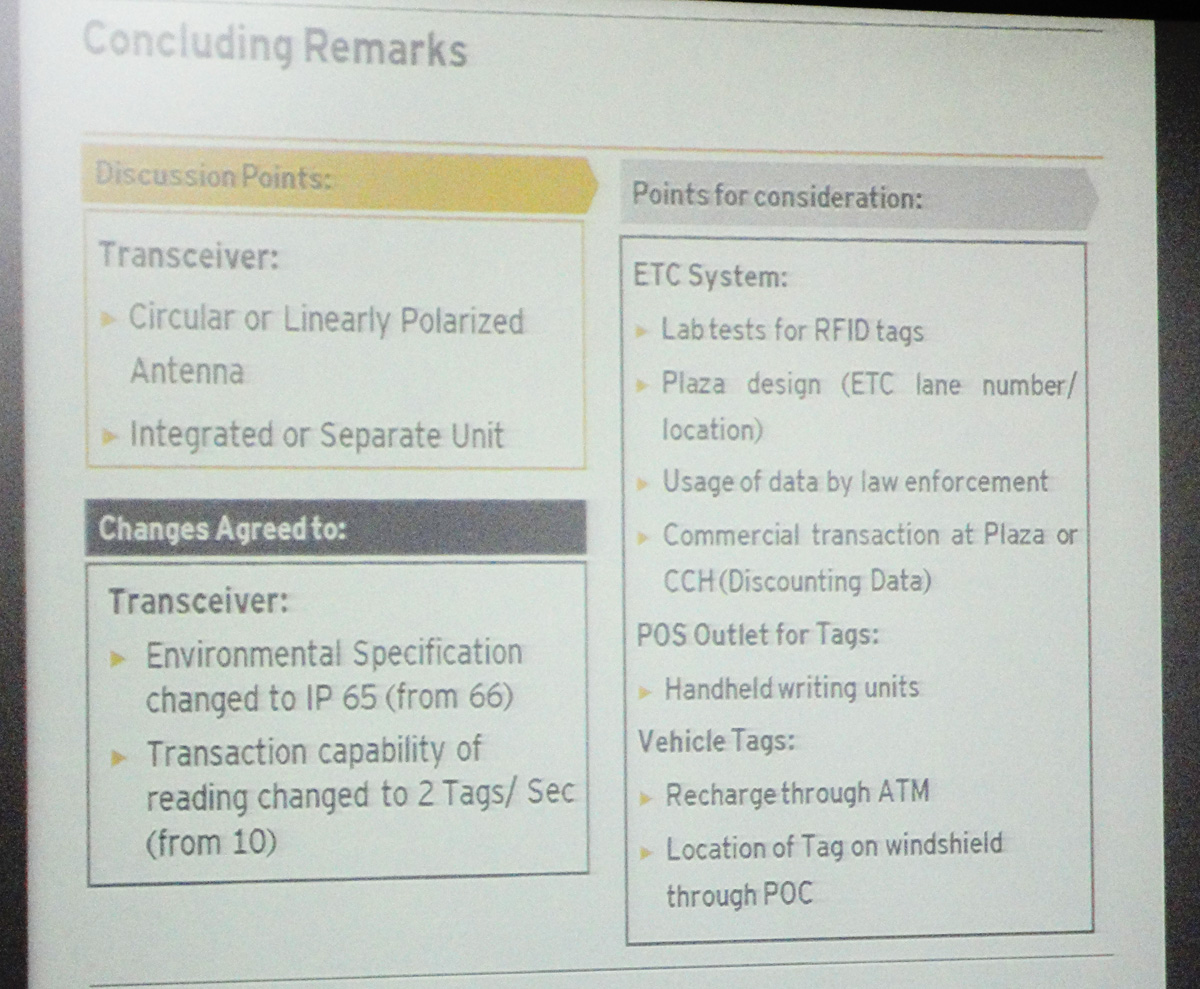Uttarakhand CM unhappy with BRO
December 9, 2013
D S Kunwar, TNN
DEHRADUN: Uttarakhand chief minister Vijay Bahuguna on Saturday expressed dissatisfaction over Border Road Organization’s (BRO) inability to complete reconstruction and repair work on the Uttarkashi-Gangotri, Uttarkashi-Yamnotri and Gaurikund-Kedarnath highways within the timeframe it was given.
“I am completely unhappy over the way BRO has been doing its job,” he said. This comes nearly six months after flash floods hit the state causing extensive damage to crucial highways in Rudraprayag, Chamoli and Uttarkashi districts.
“I am sure the central government will consider our request keeping in view difficulties being faced by victims living in disaster struck areas in these districts for want of timely reconstruction of these roads,” additional chief secretary Rakesh Sharma said.
Bahuguna said as most of those who were rendered homeless by the disaster have declined to accept the state government’s offer to give them pre-fabricated houses.
Uttarakhand government will pay Rs 7 lakh as compensation to each family for to build their houses at earmarked ecologically safe areas. A senior IAS officer said most preferred to accept the compensation offer instead of pre-fabricated houses.
Bahuguna said the government has been paying Rs 3000 as monthly rent to each family till their houses are reconstructed. “I think this monthly rent for each affected family will considerably help them,” he said.
Better than peers
September 6, 2012
While the construction sector is going through a rough phase for the last two financial years, Simplex Infrastructure Ltd has done relatively better than its peers like IVRCL Infrastr-uctures and Projects Ltd, NCC and Hindustan Construction Co. Not only has the company exhibited consistently strong execution with topline growth of over 20 per cent, but it has also witnessed lesser pressure on the bottomline despite high interest costs. However, with increasing exposure to BOT (build-operate-transfer) projects, the company’s debt levels are on the rise, which is seen as the biggest risk.
Nevertheless, analysts remain positive on Simplex despite the challenges continuing for the construction sector. Says Parvez Akhtar Qazi, analyst at Edelweiss Securities: “Simplex is one of the few pure contracting plays available in the construction industry.” Adds Deepak Purswani, analyst at ICICI Direct: “Its strong well-diversified order book, relatively lower equity commitment towards subsidiary and execution capabilities make it a strong candidate for re-rating in multiples when the macro environment improves.” The stock, which has done better than its peers (except for IVRCL, which had gained on news of possible takeover Essel group) in the last one year, is likely to sustain its lead going ahead.
Consistently better performance
Simplex exceeded analysts’ expectations in the June quarter, wherein its performance was even better compared to FY12. The June quarter was the fourth consecutive quarter of revenues growing in excess of 25 per cent. The company has been able to report better performance (compared to its peers) partly due to its well-diversified and balanced order book in terms of sectors, clients and geographies.
| SIMPLEX: HEALTHY OUTLOOK | ||
| In Rs crore | FY13E | FY14E |
| Net sales | 6669.3 | 7459.7 |
| % change y-o-y | 13.1 | 11.9 |
| Operating profit | 591.7 | 663.0 |
| % change y-o-y | 29.0 | 12.1 |
| Net profit | 103.8 | 118.0 |
| % change y-o-y | 16.4 | 13.6 |
| EPS (Rs) | 21.0 | 23.8 |
| P/E (x) | 9.1 | 8.0 |
| E: Estimates | ||
The top three sectors contribute 70 per cent of total order book with building and housing (25 per cent) having the biggest contribution followed by roads and power (each 23 per cent). Also, the company has lower presence in capital intensive and high gestation BOT projects. Says Nitin Arora, analyst at Angel Broking: “Simplex is a well-diversified player in terms of sectors, geographies and client mix and, unlike its peers, has limited exposure to road BOT assets.”
| HOW THEY STACK UP | ||||||||
| In Rs crore | Simplex | IVRCL | NCC* | HCC | ||||
| FY12 | Q1′ FY13 | FY12 | Q1′ FY13 | FY12 | Q1′ FY13 | FY12* | Q1′ FY13 | |
| Net sales | 5,897.6 | 1,585.3 | 4,971.0 | NA | 6,665.0 | 1,793.0 | 8,158.0 | 969.4 |
| % change y-o-y | 23.8 | 25.7 | -12.0 | NA | 7.0 | 11.9 | 14.1 | -8.4 |
| Operating profit | 458.6 | 126.9 | 377.0 | NA | 897.5 | 204.5 | 423.5 | 68.9 |
| % change y-o-y | -2.5 | 5.7 | -26.6 | NA | 25.5 | -40.7 | -26.0 | -50.1 |
| Net profit | 89.2 | 20.1 | 36.0 | NA | 54.9 | 20.3 | -364.0 | -40.5 |
| % change y-o-y | -27.6 | -16.5 | -77.2 | NA | -75.0 | -35.0 | NA | PTL |
| * Consolidated; NA is not available; PTL is Profit to Loss Source: Companies | ||||||||
But, some concerns emerging
Though the company’s order book of Rs 15,500 crore gives revenue visibility of 2.3 times (based on FY13 estimated sales), the same has grown only 5.5 per cent since FY11-end. Also, 55 per cent of total order inflow (Rs 1,870 crore) in the June quarter was from in-house road BOT project. With slowing economic growth, order inflows remain a concern across the sector, including for Simplex. The management expects order inflow and order book to remain flattish if the environment continues to remain challenging. Acco-rdingly, it has given a top line growth guidance of 10-15 per cent in FY13 despite good show on the topline front in the June quarter.
Further, the company’s debt at Rs 2,400 crore as on June 30 was higher than Rs 2,130 crore at FY12- end. Its debt to equity ratio at 1.8 times is also expected to rise due to its increasing BOT presence and growing working capital requirements. While it has added two road BOT projects to its existing three totalling to five road assets worth Rs 4,000-odd crore in the June quarter, its working capital cycle also worsened to 132 days as compared to 113 days in March 2012 quarter.
Says Abhinav Bhandari, analyst at Elara Securities: “The present net debt to equity ratio threatens to reach 2.5 times over next four-six quarters considering no major easing in the operating and financing environment, coupled with pending equity infusion across existing assets over the next 24-30 months.” Analysts feel rising leverage could negate the impact of strong topline growth and good operational performance.
SOURCE: http://www.business-standard.com
New road projects less profitable: CRISIL
June 4, 2012
The average return on equity on road projects awarded in 2010-11 is likely to be 6%-8% lower than those contracted before 2009, according to a study by ratings and research agency CRISIL.
The study estimates that toll road projects awarded on build-operate-transfer basis before 2009 could earn developers an average equity return of 22%. In comparison, projects awarded in 2010-11 may see a drop in returns to about 14% due to high premiums offered by developers to the government. Generally, road developers target a return of 16%-18%.
SOURCE: http://articles.economictimes.indiatimes.com
Project of six laning of Vijaywada –Gundugolanu section of NH 5 in Andhra Pradesh
January 16, 2012
The Cabinet Committee on Infrastructure today approved the implementation of the project of six laning of Vijaywada –Gundugolanu section of NH 5 in Andhra Pradesh under NHDP Phase V on DBFOT basis in BOT (Toll) mode of delivery.
The total project cost estimated will be Rs.2011 crore out of which Rs.327 crore will be for the land acquisition, rehabilitation, resettlement and pre-construction.
The total length of the project will be 103.590 kms.
The project, on completion, will reduce the time and cost of travel for traffic, particularly heavy traffic, plying between Vijayawada – Gundugolanu. It will also increase the employment potential for the local labourers for the project activities.
The main objective of the project is to expedite the improvement of infrastructure in Andhra Pradesh, increase the capacity of Golden Quadrilateral corridor and also to reduce the time and cost of travel for traffic, particularly heavy traffic, plying between Vijayawada- Gundugalanu. The National Highway No.5 is an important link connecting Kolkata to Chennai, which is part of the Golden Quadrilateral Corridor. This will facilitate road users, particularly traffic on Chennai-Kolkata section of Golden Quadrilateral passing through Guntur, Krishna and West Godavari districts and Chennai- Hyderabad and Kolkata – Hyderabad section.
The project is covered in the districts of Guntur, Krishna and West Godavari in Andhra Pradesh.
Background:
Cabinet Committee on Economic Affairs in the meeting held in October 2006 approved six laning of 6500 km of four-lane National Highway comprising 5700 km of Golden Quadrilateral and 800 km of other sections at a cost of Rs.51,210 crore under NHDP Phase V. Of the total investment required, Rs.35,692 crore is expected to come from private sector and the balance Rs.5,518 crore from Government funding for bridging the viability gap and for the cost of land acquisition, utility shifting, consultancy etc. The average cost per km after acceptance of the recommendations of B.K. Chaturvedi Committee by the Government is now Rs.10 crore /km for NHDP Phase-V projects.
BEML bets big on mining equipment
November 28, 2011
BEML Limited, the Bangalore-based defence ministry undertaking, is looking at a turnover of Rs 2,000 crore from the mining and construction equipment business during the current fiscal (2011-12), a growth of 25 per cent over last fiscal, a top company official said.
“We have a strong order book of Rs 6,000 crore on hand and we have just enhanced our product portfolio with the launch of Rail-Road Excavator among others. We have a strong enquiry from the Indian railway contractors and road developers for this product,” V R S Natarajan, chairman and managing director, BEML, told Business Standard on the sidelines of Excon 2011, international exhibition on construction equipment, here.
The Rs 3,500 crore BEML has three main business units such as mining and construction, defence, rail and metro. It has recently forayed into aerospace components business. It manufactures dozers, excavators, dumpers, pipe layers, walking draglines among others in the mining and construction business segment.
BEML is also looking at revenue of Rs 1,500 crore from the railway business and another Rs 1,000 crore from the defence segment. The company recently secured an order worth Rs 1,400 crore from the Army for supply of 204 units of Armoured Recovery Vehicles (ARVs) based on T72 tanks. It also received an order for supply of 135 intermediate metro coaches from Delhi Metro Rail Corporation Limited (DMRCL) recently, he said.
“We are in an advanced stage of securing an order worthRs 300 crore from Jaipur Metro for supply of 40 coaches on standard gauge platform. This order will be increased to 100 units going forward worth Rs 600 crore, Natarajan said. He said the company is also in the process of supplying intermediate cars to Delhi Metro.
“Delhi Metro is going for a big contract for supply of 400 cars. We also expect them to place an order for standard gauge intermediate cars. They are going in for an 8-car train set from the existing 6-car train set. We are currently negotiating with them for an order for about 100+ units,” he said. For Bangalore Metro, the company is set to deliver 150 coaches and expects to supply another 90 coaches in the second phase. Once, the Bangalore Metro Rail Corporation Limited (BMRCL) goes for a 6-car train set from the existing three car train set, another 150 coach order is expected, he said. In addition to this, BEML is also looking at other Metro rail projects like Hyderabad and Kolkata.
“The BOT (build, own and transfer) operator for Hyderabad Metro, which is L&T, has floated the tender for rolling stock. We are the strong contenders to bag this order. Apart from this, we are also looking forward to participate in the international projects like Dubai, Abu Dhabi, Qatar, Colombo, Malaysia and Dhaka. All these countries are likely to float tenders shortly. We will work with international consultants and our technology partner, Rotem of Korea in all these projects,” Natarajan said.
BEML is also set to export five numbers of dredging units to Bangladesh under a line of credit between India and Bangladesh. The company has tied up with Vosta of Holland for technology to manufacture dredgers at its Mysore facility. The company aims to capture at least 25 per cent of the Rs 6,000 crore dredging market in India, Natarajan added.
Source: business-standard.com
The construction sector is besieged with hurdles that are hampering growth.
October 3, 2011
India’s construction story has great relevance at a time when most metros have lesser space for development and a large number of people from tier-II and tier-III cities are flocking to the cities, which has put enormous strain on the infrastructure in metros. However, for companies in the construction sector, this has resulted in stiff competition, thus bringing down the Internal Rate of Returns of most of their projects.
The construction sector has been in the news of late. Firstly, increasing interest rates has ensured that it is a topic of discussion among the general public and secondly, delays in rolling I out of projects by the government has been a cause of concern for construction companies in the last few months. These have resulted in the downgrading of a number companies in the sector.
So what exactly are the problems that are posing hurdles for the sector’s growth? At a time when interest rates are rising and companies are in the cost-cutting phase, would construction companies be able to find a firm footing in the coming quarters? We give you a lowdown on the opportunities in the construction sector and the problems that are making it difficult for construction companies to turn these opportunities into visible earnings.
THE INDUSTRY
The construction industry is directly related to the infrastructure of the government and corporations in different sectors. It is estimated that under the 11th Five-Year Plan (FY08-12) around Rs.11 trillion has been spent on infrastructure.
Of the total estimated amount of Rs.20 trillion, Rs.9 trillion is to be spent in FY12. Apart from this, the 12th Five-Year Plan is expected to entail an investment of Rs.41 trillion in infrastructure projects, which means the investment allocated to this sector is over 200% in comparison with the previous Five-Year Plan.
In addition to this, other sectors such as power, road, irrigation, port, airports and water infrastructure depend heavily on construction companies as enablers of growth. In the coming two fiscal years, these sectors are likely to present enough order book and earnings visibility for the construction companies.
a) Power Sector
Experts believe that if the government follows the investment pattern of the Eleventh Plan, a substantial amount of investment would be channelized into power generation, transmission and distribution segments of the power sector in the Twelfth Plan. After providing for investment in these sectors, the remaining investment would find its way into roads, irrigation as well as water supply and sanitation.
In addition to this, India’s power capacity is expected to treble in the Eleventh Five-Year Plan. In comparison to the Tenth Five-Year Plan of adding capacity of 12 GW of thermal power, it is expected that the Eleventh Five-Year Plan would add a capacity of 50 GW.
Additionally, private players in the sector too would play a crucial role in it and is estimated to account for 56% of 27 GW supposed to be added in FY12. Hence, there is enough opportunity for construction companies that would be building power plants to meet the power demand in the country. The estimated opportunity for the construction companies would be worth $56 billion or Rs.254 crore, approximately. The Power Grid Corporation of India, which is the central nodal agency for maintaining national and regional transmission grids, has a capital expenditure of Rs.550 billion, which it would spend in the span of four years ending 2012.
b) Roads
Roads form an integral part of the order book of construction companies. Being a developing country, infrastructurally speaking, roads in the country are in a bad state and suffer from under capacity.
The government has come up with programmes such as the National Highway Development Project (NHDP) and the Pradhan Mantri Gram Sadak Yojna (PMGSY) to upgrade the national highway network and the rural road infrastructure, respectively. Projects have also been undertaken at the state level to upgrade state highways. Multi-lateral agencies like the World Bank and the Asian Development Bank have been involved in funding a number of projects at every level.
Under NHDP, the government has planned to develop 49,987 km of national highways. Projects like the Golden Quadrilateral and the North-South/East-West corridors are almost complete. However, projects whose cumulative length adds up to more than half of the total length to be developed under the NHDP, are yet to be awarded. Estimated projects worth $55 billion are yet to be awarded and may be issued in FY11-14 if NHDP is to be completed by its deadline.
c) Water Infrastructure
Water infrastructure is in dire need of investments. There is a scarcity of fresh water in India. Nearly 85% of water in the country is used for irrigation. Every year some regions of the country face drought, while others face floods. Scanty rainfall received last year and the spate of farmer suicides in recent years have brought the government’s attention to the development of water resources and channelize the supply to every corner of the country.
The government has set aside nearly Rs.415 billion for water projects. This forms about 71% of the total allocation under the Jawaharlal Nehru National Urban Renewal Mission (JNNURM). The projects under JNNURM are meant to establish and upgrade infrastructure in cities with water supply, sewerage and drainage being the top priority. Providing clean drinking water and treating and disposing sewage are the main objectives of the programme. Hence, these projects provide enough opportunities for the construction companies to cash on.
ISSUES
However, there are several roadblocks obstructing the growth of construction companies. The construction companies are finding it difficult to secure consistent orders. There have been delays due to lack of clarity on land acquisition, fuel linkages, and financing. Also, projects are getting unviable due to outdated costs and insufficient manpower. Another important reason for delays is regulatory norms on the part of the government, which is probing a host of scams. These obstacles have stalled swift issuance of projects and, hence, increased interest cost of companies.
Construction companies are also facing a problem of increase in working capital cycle. A working capital cycle is defined as the number of days taken by a company to procure revenues for its projects. The working capital cycle of construction companies has widened in the past few years due to issues such as credit crunch in FY09, delay in payments, slippages in execution of projects and change in mix of projects.
The working capital cycle for companies has increased from 85 days to 145 days. This deterioration in the last two quarters is mainly due to delays in payments and increasing loans and advances.
This has resulted in higher borrowing, thus impacting profitability. Most companies’ loans and advances shot up because of increasing loans to their subsidiaries for investments in BOT projects, which will be returned once the projects become operational.
As a result of increasing working capital cycle of construction companies, the debts on their books have been rising. Most construction companies still maintain a debt to equity ratio of less than 1. However, with high working capital these companies have to stretch their balance sheet to fund future growth. More so with rising interest rates, the resultant increase in cost of funds would hurt profitability of companies. Also, execution of projects in the last two quarters has slowed down. Much of the negative impact of these factors can be seen in the lackluster performance of most construction companies in the sector in the June ’11 quarter.
Going forward, it is important that the government clears projects promptly and urgently. Traditionally, the third and fourth quarters of a fiscal are considered to be better than the first and the second quarter.
Experts believe that it would take few more quarters for the sector to enjoy the desired momentum in project execution considering inflationary and interest rate concerns. However, most big-sized companies are likely to see revenues coming in the next three to four years.
Source: stockmarketsreview.com
Workshop on Nationwide Electronic Toll Collection, held at Vigyan Bhawan, New Delhi on June 14, 2011
June 15, 2011
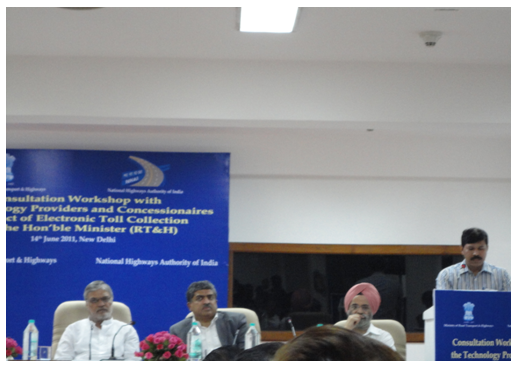
Workshop on Nationwide Electronic Toll Collection
- Mr. C P Joshi , Honrable Minister Road Transport and Highways
- Mr. Nandan Nilkani , Chairman , UIDAI
- Mr. R S GUJRAL , Chairman NHAI
- Mr. Ravi Palekar , GM (Electronics) , NHAI – Addressing the gathering
- Mr. Sachin Bhatia, CEO, Metro Infrasys
Workshop on Nationwide Electronic Toll Collection held at Vigyan Bhawan, New Delhi. With an objective of paving way for a unified Electronic Toll Collection (ETC) technology for National Highways in India, the Ministry of Road Transport & Highways constituted a Committee under the chairmanship of Shri Nandan Nilekani Chairman of UIDAI with a mandate to examine all technologies available for Electronic Toll Collection (ETC) and recommend the most suitable one for implementation throughout India. The other members of the Committee are Prof. Pankaj Jalote, Director, IIIT-Delhi ; Dr. Kolin Paul, Asst. Professor, IIT-Delhi ; Shri A.V. Sinha, DG (Road Development) & Special Secretary, MoRT&H and Shri. V.L. Patankar, Member (Technical), NHAI (Member Secretary).
The Union Minister for Road Transport & Highways Dr. C.P. Joshi has said that we should chalk out a plan to increase the percentage of national highways from present 2.2 % to 5 % in the next 10 years. Delivering inaugural address at the Consultation Workshop with the Technology Providers and Concessionaires in respect of Electronic Toll Collection (ETC) here today, he said that keeping in view the various types of highways there should be a hybrid pattern of toll collection. The Workshop was jointly organized by Ministry of Road Transport & Highways, National Highways Authority of India & National Informatics Centre. The Chairman of UIDAI Shri Nandan Nilkeni & Minister of State for RT&H Shri Tusharbhai A. Chaudhary also addressed the workshop. Shri R.S. Gujral, Secretary Ministry of Road Transport & Highways and Dr. V.K. Gairola, D.G (NIC) were present.
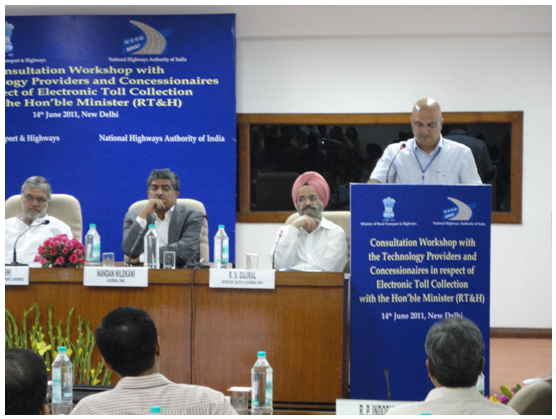
Mr. Sachin Bhatia CEO Metro Infrasys expressing the support from Industry Fraternity
Based on the recommendations of the committee headed by Mr. Nandan Nilekani to use RFID technology for ETC, the Apex Committee, responsible for ETC implementation planning, is in the process of prescribing certain standards which should be complied with all over the country to ensure interoperability. The primary purpose of this workshop was to take feedback from the key stakeholders, comprising concessionaires and ETC technology service providers. Security, cost effectiveness, convenience and scalability have been the main criteria based on which the detailing has been done.
Based on the feedback, the specifications and data detailing will be finalized for open market release. The plan is that the authorized manufacturers will be producing Transceivers and Tags based on these standards, the concessionaires will be procuring these Transceivers and in turn, the technology service providers will be integrating the entire ETC system at the toll plaza. Although details on other aspects like clearing house are being worked out simultaneously, majority of the decisions will depend upon these standards only.
Followings are the Tolling Companies, RFID Manufacturer and concessionaire took part in the workshop:
- Kapsch Metro
- Egis Infra
- L&T Infra
- GMR
- HCC Infrastructure
- JICA
- IRDSA
- DSC
- EFKON India
- Siemens
- IAITO Infotech Pvt. Ltd.
- ESSEN, Mumbai
- ATT System, Banglore
- Mitsubishi
- IBI Group
- Neology
- Steria
- Tag Factory
Brief of discussion over finalization of technology between committee and Industry Peoples:
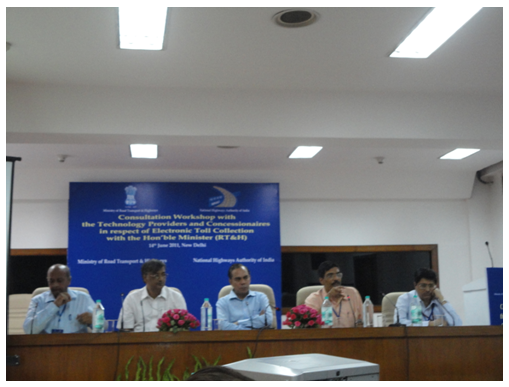
- Dr. B.K. Gairola, Director General, NIC – extreme left
- Dr. Y.K. Sharma, DDG, NIC - middle position
- Dr. Rajat Moona, Director General of CDAC, IIT Kanpur
- Dr. Y.K. Sharma, DDG, NIC - extreme Right
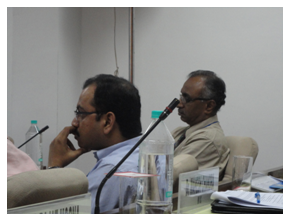 Mr. Venkat from GMR expressed change from IP 66 to IP 65 for the readers as IP 65 is also good enough and IP 66 will increase the cost for the readers without any additional value.
Mr. Venkat from GMR expressed change from IP 66 to IP 65 for the readers as IP 65 is also good enough and IP 66 will increase the cost for the readers without any additional value.
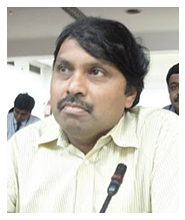 Mr. Hari from Efkon
Mr. Hari from Efkon
He raised an issue over the relative humidity of 100% for Transceiver antenna.
Committee Conclusion :
Committee agreed for the IP 65 standard and 95% relative humidity as it comply against all possible environmental threat at toll scenario.
 Mr. Anand Shenoy from IAITO Infotech Pvt. Ltd.
Mr. Anand Shenoy from IAITO Infotech Pvt. Ltd.
Raised his voice over minimum requirement of reading of 10 Tags per second with 240 bits of EPC memory and 64 bits of Tag Id.
Committee Conclusion: committee agreed onto change it to 2 Tags per second with above said minimum requirement. On the other query raised by Mr. Shenoy that the data retention period must be 3-4 year for the tag memory instead of 10 years as their is no UV protection asked for the tag and without any special material with the effect of UV rays its hard to maintain the data in tag for 10 years, The committee replied as they will keep it under consideration and if required they will bring it in next phase.
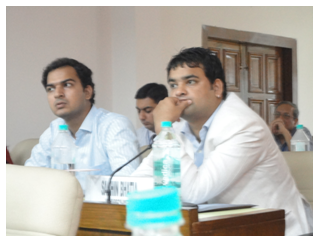 On the query raised by Team from Metro Infrasys- Mr. Nitin Thakur and Mr. Harimohan for the option of having color coded Tags for different class of vehicles, as it will help in operation at toll plazas. The Committee said that it is difficult to see the color in the moving car in the sun. However committee will discuss it in next phase.
On the query raised by Team from Metro Infrasys- Mr. Nitin Thakur and Mr. Harimohan for the option of having color coded Tags for different class of vehicles, as it will help in operation at toll plazas. The Committee said that it is difficult to see the color in the moving car in the sun. However committee will discuss it in next phase.
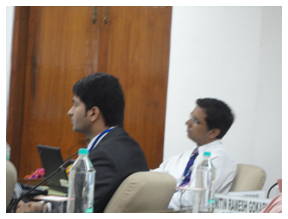 Mr. Vipul Sharma(Left), Mr. Mayank Manish(Right)
Mr. Vipul Sharma(Left), Mr. Mayank Manish(Right)
The long discussed topic was the polarization standard for the antenna, Panel has asked for circular polarization pattern for the antenna but Mr. Vipul Sharma and Mayank Manish from one of the leading manufacturer of RFID Equipment Neology reasoned to have it linearly polarized due to its long range and less interference phenomenon, also linearly polarized antennas can work at higher speed , committee keep this for discussion and will revert again.
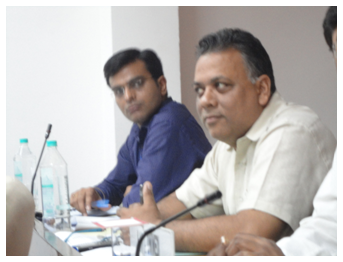 Mr. Manoj Agarwal and Mr. Manish from Delhi Gurgaon Expressway strongly supported the idea of a law for putting a penalty on cash vehicles coming to Tag lane .
Mr. Manoj Agarwal and Mr. Manish from Delhi Gurgaon Expressway strongly supported the idea of a law for putting a penalty on cash vehicles coming to Tag lane .
For the standard for the communication between plaza server and CCH server, there will be addition of Plaza id into the prescribed format by the committee. Plaza level fare plan and policy will be governed by the plaza itself while the global discount will be governed by the CCH server and will be updated in all the plaza server by CCH server itself. Committee also agreed to look into the various aspects of fare plans at different plazas.
Highlights of the Workshop:
ETC critical components:
Tag Distribution Channel & Inventory Management
- On-line channels by user
- Authorized service centers of vehicles (Service centre need to install the SPV client software and antenna connection), since centre must have authorized people to affix tags.
- RTO(Operation is similar to above)
- Vehicle dealer network(Operation is similar to above)
- Authorized point of sale installation(POS can be insurance companies, PUC centers, Petrol Pumps etc; Operation is similar to above)
Inventory Management of Tags:
SPV will keep track of allocated EPC Ids, Tag Ids etc. It will perform a demand forecast Tags and keep the tags available for distribution through distribution channel.
Handling Special Cases
- Valid ETC enabled vehicle was ejected due to non-read of Tag – Premium cash lane should verify it with the ETC database.
- Clone Tag – If customer complains/suspects that his/her Tag is cloned, Tag re-initiation is to be done for same Tag. Old Tag value is marked for special handling.
- Change in registration number of vehicle – Vehicle should approach distribution channel network and get a new tag. Old tag is to be destroyed physically and listed for special handling.
- De-registration of vehicle (due to destruction/ end of life/ Export etc.)-Tag is to be destroyed physically and listed for special handling.
Listing for Special Attention
Vehicle is listed for special attention following conditions:
- Insufficient balance as determined by clearing house
- Credit card co. declined the payment
- On Police look-out
- Suspected cloned Tag
- Tag with invalid Vehicle Registration no. (e.g. when Registration no. is changed)
- When toll plaza operator notices Tag carrying details different from vehicle itself (e.g. the vehicle Registration no. and/ or Vehicle class)
Videos
Conclusions drawn at the end of the seminar:
Documents Attached:
- Agenda Workshop
- Apex Committee for ETC Implementations – GOI, Draft Specifications Document
- ETC Report on RFID – July 2010
 This story is covered by Mr. Sachin Bhatia.
This story is covered by Mr. Sachin Bhatia.
Now that the Toll Industry has had a few years of maturity. What is the summary of expections from Toll Collection System from a concessionaire’s point of view.
May 10, 2010
(This needs an in-depth analysis on broad parameters. However I have tried to analyze few problems associated with toll roads.)
M S V Ramu
Profession – Contract Manager
Date: May 4, 2010
E-mail: [email protected]
Introduction: with a need a build good infrastructure and lack funds available to finance these Highway project government has undertaken to built highway on Public Private Partnership either toll based or annuity based.
The private developers who bids and undertake constructions of Highway on toll basis needs to implement a through pertinent “risk” management system with the help of the government to mitigate all the risks that come with development.
To understand the various consequence of “tolled” roads there needs to through study to undertaken which is not my purview at the moment. Hence I dwell over some of these consequences based my exposer these projects.
Toll based Highways:
The idea of “Toll based” highways was imported into India from experiences of others countries like Europe, Malaysia or North America. The model “Concession Agreement” was drafted by the Government to suit India needs.
The toll categories of roads are those wherein there are sufficient traffic which can be tolled by the Concessionaire and recoup the investment made him and also make profit. In the event there are not enough tollable traffic to recoup the investment made, it will be offered on annuity basis or with VGP (Viability gap funding) by the government.
The tolled based roads wherein the Government grants private developer specific rights to design, finance, construct operate and maintain the roads. The developer called “Concessionaire” develops covers the investment costs and carry commercial risks since he relays on operation revenue from the tolls remunerated. At the end of the concessional period the road reverted back to government at no extra charges. However if the estimated revenue does not materialize during Concession period the Concessionaire may have to negotiate the concession period (as in other countries) which is yet to happen in India as we are just starting!
In south America there is method of bidding known as “Least Present Value” wherein the winning bidder is the one who asks for “smallest Net Present Value” and period of the concession period ends when the present value of revenue equal to winning bid. This model has not been tried in India.
Risk management in “Toll based” Concession
In the present circumstances the Concessionaire undertakes risks to constructs road which is generally divides normally into three parts:
- Certainty – decision maker know exactly the outcome
- Uncertainty – here the decision maker does not know the risks due to non availability of any data
- Risks – are those which can be determined by statistical terms and can be analyzed but it differs from uncertainty
In risk management all the risks are quantified and analyzed and decision taken by the Concessionaire to mitigate the same by way of disciplined approach to critical situation
Developmental risk involves “Land Acquisitions” needed for the project. This is one of the biggest risk faced by the Indian developers as most of the times project gets delayed due non-availability of Land. NHAI does not meet the contractual requirements specified in the Concession agreement thereby causing unnecessary hardship to concessionaire. This risk falls under “uncertainty” which can not be quantified
Financial Risk: Soon after award of Project, the Concessionaire needs to raise the necessary capital required for execution project
There are two major risks involved:
- Ability to raise the finance and make financial close as required by the Concession agreement.
- High interest rate during the currency of concession period (due to floating interest charged by lenders) – mitigation of this risk in extremely important).
Construction risks
Whether the construction undertaken by the Concessionaire himself or by other contractor there are many risk involved
- Poor performance of the contractor
- Different site condition which normally experience contractor many not have thought off which is problematic and end up in high cost due additional items of work to be executed.
- High price escalation of all the inputs of construction – Example: steel pricing going through roof last year.
All above risk has to be born by the Concessionaire which needs proper approach in the initial stages itself
Operational risks
Operation risk involves mainly the following
State support agreement – needs to signed by the concerned state and they shall support the collection of tolls which important to the concessionaire. NHAI who are promoters of the project should take full responsibility in getting the agreement signed with Concessionaire as Concessionaire can not exert any pressure on the states
Toll Level: the estimated toll level uncertainty during pre-bidding stages can lead to inaccuracies in revenue estimation which the Concessionaire has based his bid. Hence this risk needs to shared by the NHAI
The traffic volume projected in financial model may not materialize as it completely depends on economic growth projected during pre-bidding stage
Any fall in traffic volume will automatically bring down the IRR value projected. Expert estimate that 10% drop in volume of traffic will result in reduction of 1-7% – 1.9% percent reduction in IRR.
Toll collection
The Concession agreement does give any standard specification for the installation of tolling equipment. This has resulted in haphazard manner the tolling equipment being installed by the different Concessionaire. This needs to change. For example a RFID card issued at New Delhi should also hold good down south. By such an arrangement the road user can travel effortlessly any ware in India.
The technology used by the Concessionaire needs to be streamlined on all India basis for all Concessionaire.
Toll fee: The price escalation of “toll/Fee” charged by the Concessionaire is based on all India WPI index. This is incorrect as in some states it may be very high. In my opinion there should be “Toll Regulator” on all India basis to regulate toll based on each state WPI or any other base model
HTMS: Here there is no comprehensive approach. For example the “variable message system” is limited to one project length only! This also needs an all India approach.
Suggestion: at the moment there are so many “Toll” based road are in operation and also on the horizon. All the toll based roads owners are “Special purposed vehicle” promoted by the concessionaire.
So why not a “over the counter” stock listing be arranged of these SPV and listed in Stock exchanges which can also traded in F&O section. I am sure this arrangement will automatically will mitigate many risks and also give scope for improvement in roads as the Concessionaire would like increase the traffic by enhancing the many amenities for road users.
Thanks for taking time for reading this articles.
Indian government has finally realized the importance of road sector
April 26, 2010
Huge opportunities are unfolding in the Indian road sector. This means most Indian infrastructure and construction companies will benefit from the announcement of new orders or projects in the long run.
Also, a large number of these projects are on Build Operate and Transfer (BOT) and annuity basis, which means the companies will have a steady flow of cash through annuity or toll. This development spells good news for investors who can make full use of this golden chance and earn high returns in the long run.
WHY NOW?
The question that may cross your mind is why now? Ever since Kamal Nath took over as the Union minister for roads and transport, the Indian road segment has taken a new turn. He created various milestones since he was given this portfolio.
The most important announcement he made was the construction of the national highway at the rate of 20 km per day to expedite the achievement of National Highway Development Programme (NHDP) targets. This is significantly higher than the current execution rate of about 6 km per day. The ministry has also been working towards faster clearances related to procedures, land acquisitions and other formalities.
CREATION OF FUNDING
Kamal Nath is aware of the fact that improved road network in the country would not just lead to better connectivity but would also lead to increased energy efficiency in transport operations. He also travelled across different countries on road shows to international investors to highlight opportunities and potential in the Indian road sector.
Through these measures, the government has and will be able to rope in huge investments needed for the sector from international and national long-term investors.
Earlier it was difficult to raise money for more than five years or so as money was available only for a short period. However, now that the corporate debt market is developing, long-term investors like pension funds, mutual fund houses, insurance companies and even banks are coming forward to provide long-term capital. Most road projects, particularly the BOT ones need huge long-term investments in the form of debt and equity to fund them.
INCREASING VIABILITY
In terms of the less viable projects, the government increased the viability gap funding (VGF) or grant to 40% from 25%. Formerly, the grant used to be given after the completion of the project. But now it is handed over at the beginning of the project. In this manner the construction of the project does not get delayed for want of funds.
The government is also working on creating innovative ways of structuring non-viable projects like allotment of land, which can be monetized by developers so that the returns on investments are reasonable.
Other aspects like increasing the role of private players through public private partnership (PPP) and awarding of projects on BOT basis would mean that private players now have a bigger role to play in the construction of viable road projects.
A LONG WAY TO GO
India currently has about 33 lakh km of road network spread across the country. This is the third largest network in the world. But, in terms of density and quality of roads, India still lags behind many developed and developing countries of the world.
In relation to our population, the country’s roads are about 3 km per 1,000 persons, which is significantly lower than the world average of about 7 km per person. In terms of quality, about 80% of our roads are in a poor condition and require huge investments for repair, renovation and increase in the number of lines.
Majority of India’s roads are single line in spite of increasing traffic and congestion. Even the conditions of our existing roads are so bad that India’s logistical cost as a percentage of total production cost is considered to be about twice the world average of 7%.
No wonder due to the poor road infrastructure, India is ranked 87th in the world on the basis of quality of roads, which is very low and considered to be the biggest hindrance for economic growth as envisaged by the government for the coming years.
Surprisingly, within this vast network of roads, only about 2% is accounted for by national highways and a very minuscule part is accounted for by express highways, which is very critical considering that about 40% of the total road traffic is handled by national highways.
The slow transportation of goods has also affected the movement of goods among states, delaying exports and imports of the country. Especially, in the case of transportation of perishable goods like milk, vegetables and flowers among other things, which are procured from the hinterland takes so much time that they become stale or get destroyed before they can actually reach the end consumer and the export market.
This leads to wastage of goods due to the delay in reaching the markets. Express road connectivity to the main ports of the country and to major cities is very important to improve trade volumes and discover better prices for farm goods.
WHAT IS CHANGING?
The government has realized the importance of better roads in the country so that it can support the growth of the economy in the coming years. Roads are critical for any economy, especially a growing economy like India with a large population and different topographies.
The role of roads is of paramount importance for commercial and economic activities in the country. In India, passenger traffic is growing at about 12% per annum, while cargo traffic is growing over 15%, which will continue to rise as economic activities improve along with the increase in foreign trade.
India’s foreign trade is growing at 10-12 % and there is an immediate need to connect all the major ports of the country. The government has taken the first step in this direction. Under the NHDP (phase II), the government will connect major ports and build freight corridors, which will connect many states from the eastern part of India to western India.
In phase III of the NHDP, all major capitals will be connected with highways. Also major cities and points that could not be connected in phase II will be connected with better road infrastructure. Besides, plans are afoot to improve and connect rural India to major cities of the country soon.
EASING HURDLES
Most of these plans are not just on paper. In fact the government has already awarded projects to achieve this goal. The government formed the BK Chaturvedi Committee, which presented its findings and suggestions to make progress in the sector.
Based on the findings of the committee report, several changes have been incorporated and more importantly, the government is seriously working on the recommendations, which are quite innovative and provide solutions to various problems that the companies have been facing.
Changes have been incorporated with regard to land acquisition, which is the biggest problem for construction of roads in the country.
Now, NHAI will work along with the state governments for facilitating land acquisition and all state governments have been directed to coordinate for the same. NHAI now awards road projects only after 80% of the land has been acquired.
FEW SPEED BREAKERS
Tackling delays in approvals, decision-making, faster resolution of disputes and coordination among different departments are few other highlights of the recommendations of the committee report.
Essentially, most of the changes are already in effect and new orders are awarded to interested parties. The flow of new road orders in the last few months was the highest in the last several years. This itself speaks volumes about the commitment of the government and its intention to put things on ground.
Also, the projects which were not viable and did not attract private participation were given extra focus and restructured within time frame along with consultations of private players while changing the terms and conditions of the project. There are other measures also which have attracted private participation in road projects.
Large projects will be built on a BOT basis, which are expected to have a higher return of about 18% to 20% on investments as compared to 14% to 16% earlier. Additionally, the new guidelines that have been framed are such that once a project is awarded for a particular road, the private player is given an assurance that there will not be any competition or construction of road, which will make sure that the cash flow in terms of the collection of the toll is protected.
What is more remarkable is that the government now has experts as representatives from development agencies like the World Bank, the Asian Development Bank, who make sure that the projects are not delayed and hurdles are resolved.
These representatives keep track of projects and act as a liaison between government agencies and private parties. They also bring their experience to structure the project in such a manner that it gets executed.
QUANTUM OF OPPORTUNITY
There are different estimates about the size of the opportunity. But there is little or no doubt that the opportunity is far bigger than what it used to be a few years ago.
When we talk about 20 km per day of the construction of roads, this in itself is self-explanatory. This means that the country will have to build about 7,300 km of roads every year. This is significant as the current run rate is just about 2,500-3,000 km of roads built every year.
One could also imagine the kind of work that will now flow. For the eleventh five year plan which will end in 2012-13, about Rs 3.14 trillion will be invested as compared to Rs 1.45 trillion invested in the tenth five year plan. This is still the tip of the iceberg. India’s investment in the roads segment is expected to be in the range of Rs 10.5-11 trillion over the next decade.
In the near term, about 5,000 km of new expressways will be built and the projects will be awarded for the same. Also, NHAI has plans to award work for about 37,000 km of roads over the next three years.
Besides, under the NHDP’s different phases, the government will award work relating to the upgradation of about 55,000 km of roads over the next 8-10 years.
WHO WILL BENEFIT?
Most construction and infrastructure companies are focusing on this particular segment and their exposure has gone up in the recent past. IRB Infrastructure and IL&FS Transport Network (ITNL) are popular in the roads segment having the highest exposure to the road segment. In the case of IL&FS, the company has recently come out with an IPO and was listed recently.
ITNL is amongst the largest private sector BOT road operators in the country having integrated business model providing service for projects, from conceptualization, construction to operating and maintenance of the road projects. The company has already bagged about 19 road projects.
Apart from roads, the company is also looking for opportunities in airport segments and plans to bid for more projects in this segment. The company’s advantage is its large portfolio of BOT assets and a long experience in the sector. The company has presence across different parts of the country and has about 9,397 lane km of road projects under its belt.
IRB Infra too is a leading player in the roads segment generating almost 100% of its revenue from this segment. The well-known Mumbai-Pune highway, one of its kind in India, is operated by IRB Infra.
The company has an integrated business model having large experience in toll roads and highways sector. The company has about 1,100 km of road projects in its kitty, which is the second largest among private players in the whole of India.
As opportunities are growing, the company should be able to procure more projects and increase its current portfolio. The company will not only benefit on account of the construction of these projects but also due to the collection of toll and annuity from these projects, providing stable future cash flow.
Also most of its projects are strategically located in major traffic areas like Mumbai-Pune, Mumbai-Surat, etc. The company also won projects in other states like Rajasthan and Punjab and is gradually focusing on becoming a pan-India player in the road segment.
Source: stockmarketsreview.com
TEXT-Fitch affirms SNBTPL ‘s bank loans at BBB-(ind)
April 19, 2010
April 16 – Fitch Ratings has today affirmed SEW-Navayuga Barwani Tollways Pvt Ltd.’s (SNBTPL) senior long-term project bank loans aggregating INR5,474m at ‘BBB-(ind)’, and subordinated bank loans of INR300m at ‘BB+(ind)’. The Outlook is Stable.
SNBTPL enjoys an 18-year concession from National Highways Authority of India [NHAI.UL] (NHAI, ‘AAA(ind)’/Stable) to design, engineer, build, finance, construct, operate and maintain on a Build, Operate and Transfer (BOT) basis an 82.8km road stretch on the National Highway 3 (NH-3) in the state of Madhya Pradesh. The estimated cost of the project is INR7.9bn, with the scheduled commercial operations date (COD) in May 2011.
The affirmations follow SNBTPL’s reasonable progress over the last year in achieving different project milestones during the critical construction phase. Fitch does note however that the company is slightly behind plans. The entire right of way (ROW) required for the project is reportedly in the company’s possession, with the exception of a three-km stretch of forest land; however, first-stage approvals have been received from the forest department.
As of March 2010, the project has received equity infusions (61.3%), and has been drawing down on term loans – 58% of senior debt and 57% of sub-debt – as per schedule.
The ratings are constrained by the residual completion risk, although a fixed-price construction contract with SEW, whose terms mirror those in the concession, offer protection. Base-case debt service coverage metrics are extremely modest and vulnerable to various deep stress tests Fitch performed. A three-year tail in the concession allows the banks to restructure the loans, if necessary. Some liquidity support is available in the form of a fully-funded debt service reserve account (DSRA), equivalent to three months’ principal and interest payment.
Fitch has factored into its rating the operational track record and financial strengths of the sponsors. This includes the credit enhancement value of their undertaking to finance the cost and time overruns, to replenish the senior and subordinated DSRA and to provide unconditional and irrevocable bank guarantees if event project cash flows are inadequate to create the DSRA. Additionally, SEW has executed a letter of undertaking to the senior to infuse INR100m, after the COD, to augment debt payment capacity and to inject additional funds in case operations and maintenance expenses exceed the base case projections submitted to the banks.
The agency believes that the road has long-term economic potential, and that its locational advantage should have a beneficial impact on tollable traffic. Also, it is situated on the highway that represents the shortest distance between Mumbai and Agra.
SNBTPL is a 74:26 JV between SEW infrastructure Ltd (SEW, ‘AA-(ind)’ / Stable) and Navayuga Engineering Constructions Ltd (NECL). Following inter-se adjustments among the sponsors, SEW has increased its equity stake in the project to 74% from the 51%, resulting in a reduction in NECL’s holding to 26%.
Applicable Criteria available on Fitch’s website at www.fitchratings.com: “Rating Criteria for Infrastructure and Project Finance”, dated September 29, 2009.
Source: in.reuters.com
